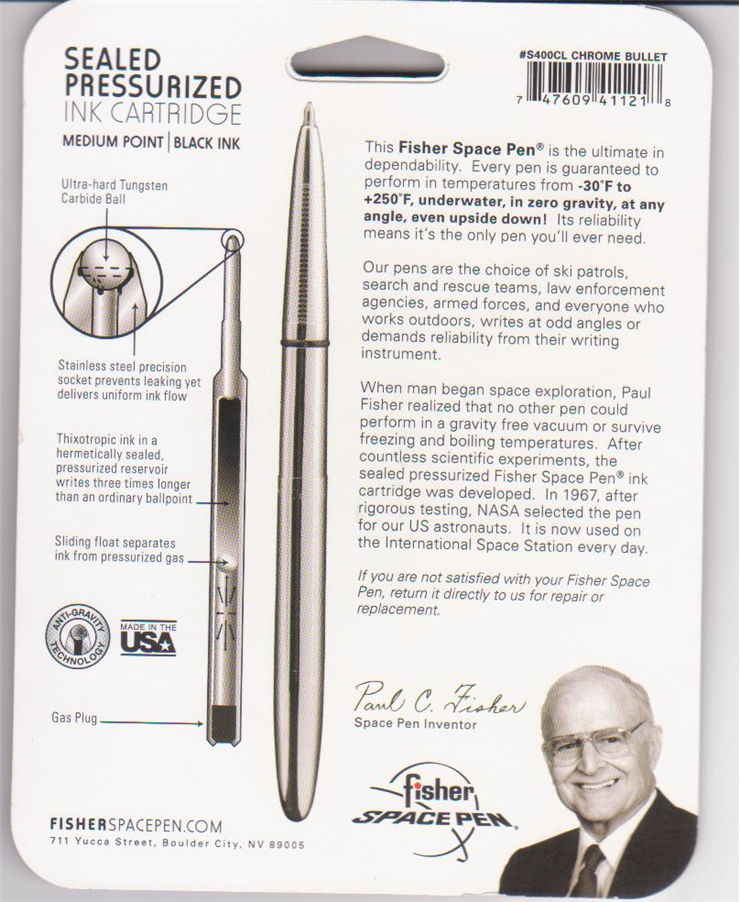History of Space Pens
Space pen is a ballpoint pen invented by Paul C. Fisher and made to work in zero gravity, underwater, and at any angle (even upside down). It is also known as Zero Gravity Pen and Fisher Space Pen, which the Fisher Space Pen Company sells.
Paul C. Fisher worked during World War II with ball bearings in an airplane propeller factory. After that, he started working in a pen factory and became an innovator. He then opened his own pen company. When he got the idea got his pen, he didn’t try to send it into space. He just wanted to make a pen that would not leak. He experimented few years, invested 1 million dollars, and made his first “Anti-Gravity” pen - the AG7, which he patented in 1966. The ink in this pen was not exposed to air but was under pressure which forced the ink out. Because of that, it didn’t rely on gravity, so that it could write upside down or without gravity. It also would not leak or dry up. It could also work on temperatures between -35°C and +120°C. The Ballpoint of a Space Pen is made from tungsten carbide. It fits precisely, not allowing leaks. In a reservoir part, gas is separated from ink with a sliding float. This prevents the mixing of gas and ink and the creation of bubbles which would prevent the pen from working. The ink used in this pen is also uncommon. It is thixotropic ink thick when it doesn’t move but turns liquid when shaken. This also prevents leaking. The gas used in pen is nitrogen, and the pen cartridge is hermetically sealed.
Simultaneously, NASA tried to find a pencil that they would use in space flights. They ordered 34 mechanical pencils from Tycam Engineering Manufacturing, Inc., in Houston, for $128.89, for use on Gemini Project. The problem with pencils (except their price in this case) was that when they broke, their tip would fly everywhere and, because graphite conducts electricity, it could short circuit something, which is very dangerous in space. Fisher offered his pen to NASA, and after two years of testing, they bought 400 pens, at $6 per pen, to be used on Apollo 7. USSR cosmonauts used grease pencils then and bought 100 pens and 1000 ink refilling.
Two models of a Space Pen are sold. One is already mentioned AG7 "Astronaut pen," which is long and thin and has a retractable mechanism of a standard ballpoint pen. Other is the "Bullet pen," which is shorter when closed and has no retractable mechanism. When its cap is placed on the rear, it gets in length and is standard size. They are sold under the promise that they have a shelf life of 100 years.
Fisher Space Pen Co. grew in time, and in 1976, they moved to a larger building in Boulder City, Nevada, from California, where they were first located. Paul Fisher was chosen as a Small Business Person of the Year for the State of Nevada in 1980. In 1996 Good Morning America named the Fisher Space Pen the best stocking stuffer. A year later Fisher Space Pen is used during Everest North Face Ski Expedition.
Other manufacturers also sell pens with some or all properties of a Space Pen. Schmidt, a manufacturer of pen refills and components from Germany, also sells pressurized refills called "Megaline." “Diplomat” (also a company from Germany) sells their SPACETEC pressurized refills and pens. Parker Pens, the company from Untitled States, sells refills that are also pressurized but use different ink.
